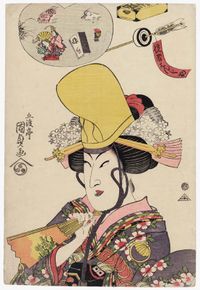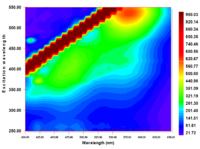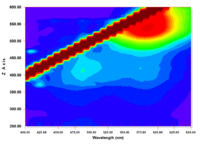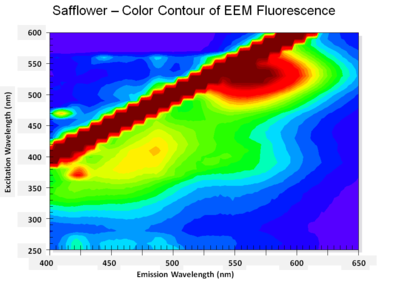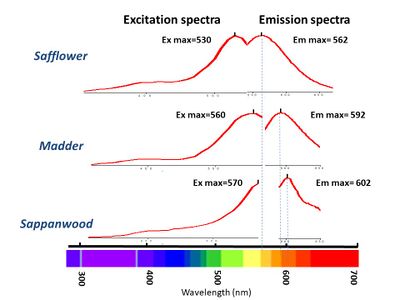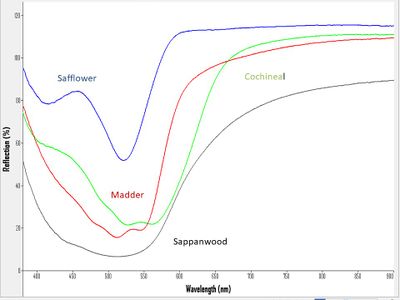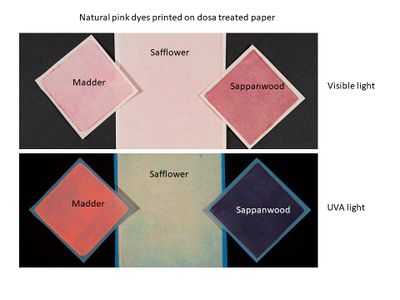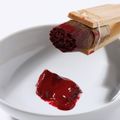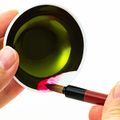Difference between pages "Hokusai, Actors Ichikawa Danjûrô VII as Asahina and Ichikawa Monnosuke III as Tsukisayo, 11.20417" and "Category:Safflower: Ukiyo-e colorant"
| Line 1: | Line 1: | ||
| − | |||
| − | + | [[File:SC323786.jpg|right|200px|link=Kunisada, Actor Sawamura Tanosuke II, from the series Actor Rebuses, 11.42324|Actor Sawamura Tanosuke II by Utagawa Kunisada]] | |
| − | + | <font size="3">'''[[Safflower]]'''</font> 紅花(''benibana''): An organic red obtained from the florets of ''Carthamus tinctorius'', it produces a wide range of tones from pale pink to red. The florets are picked, washed, massaged, and fermented to create safflower cakes (紅餅 ''beni mochi'') from which the red dye can be extracted later. Dried florets can also be used to extract the dye directly. The florets are first washed with water to remove non-lightfast yellow chromophors including several quinochalcones. The red colorant, primarily carthamin, is then extracted in an alkaline solution. Safflower was grown throughout Japan during the Edo period for use as a cosmetic and food dye. The area of Yamagata was known as a producer of high quality benibana and still produces it today. | |
| − | + | Safflower can appear as a pale pink, such as the delicate pink used to depict subtle eye shadow or blush effects as well as deeper reds. Safflower was noted to be an expensive colorant and often required multiple printings to achieve darker colors. Safflower and [[:Category:Madder: Ukiyo-e colorant|madder]] are the most commonly found reds before the introduction of aniline dyes in the 1860's. Red safflower and madder are found as a single colorant or as a mixture of the two. Although the visual difference between red safflower or madder used alone and a mixture of the two is currently difficult to discern, madder may have been used to extend the safflower. Safflower is most commonly mixed with [[:Category:Dayflower: Ukiyo-e colorant|dayflower]] to produce [[:Category:Dayflower/Safflower: Ukiyo-e colorant|purple]]. The safflower and dayflower combination is continuously detected even after the introduction of synthetic colorants such as [[:Category:Prussian Blue: Ukiyo-e colorant|Prussian blue]] and aniline dyes, which seems to indicate that the tone obtained by the two was preferred over other possible mixtures of reds and blues. | |
| − | + | '''For more information see:''' [[Safflower]], [[Safflower (Carthamus tinctorius) LC]] | |
| + | <br> | ||
| + | == Examples of Safflower in Ukiyo-e Prints == | ||
| − | + | {| class="wikitable" style="display: inline-table;font-size:90%;text-align:center;width:15%" | |
| − | + | |[[File:11.13297-pt5.png|200px|link=Kiyomasu II, Actor Ogino Izaburô I as Yamagami Gennai, Acting in the Aragoto Style with the Sumikazura Wig, 11.13297]] | |
| − | [ | ||
| − | |||
| − | |||
| − | |||
| − | |||
|- | |- | ||
| − | + | | | |
| + | [[File:11.13297-pt5eem.png|200px]]<br>[[Kiyomasu II, Actor Ogino Izaburô I as Yamagami Gennai, Acting in the Aragoto Style with the Sumikazura Wig, 11.13297|Actor Ogino Izaburo I... by Torii Kiyomasu]] | ||
| + | |} | ||
| + | {| class="wikitable" style="display: inline-table;font-size:90%;text-align:center;width:15%" | ||
| + | |[[File:11.19048-pt1.png|200px|link=Toyonobu, Rain in the Fifth Month, 11.19048]] | ||
|- | |- | ||
| − | | | + | | |
| + | [[File:Indigo FORS.JPG|200px]]<br>[[Toyonobu, Rain in the Fifth Month, 11.19048|Rain in the Fifth Month by Ishikawa Toyonobu]] | ||
| + | |} | ||
| + | {| class="wikitable" style="display: inline-table;font-size:90%;text-align:center;width:15%" | ||
| + | |[[File:11.16479-pt1.png|200px|link=Harunobu, Nishikigi of the Kanaya Lighting Incense beside a Mosquito Net, 11.16479]] | ||
|- | |- | ||
| − | | | + | | |
| + | [[File:Indigo FORS.JPG|200px]]<br>[[Harunobu, Nishikigi of the Kanaya Lighting Incense beside a Mosquito Net, 11.16479|Nishikigi of the Kanaya... by Suzuki Harunobu]] | ||
| + | |} | ||
| + | {| class="wikitable" style="display: inline-table;font-size:90%;text-align:center;width:15%" | ||
| + | |[[File:11.14971-pt4.png|200px|link=Shunko, Actors Ichikawa Danjûrô V as Fukurokuju, Iwai Hanshirô IV as Ryûyô Dôji, and Sawamura Sôjûrô III as Shin'yô Dôji, 11.14971]] | ||
|- | |- | ||
| − | | | + | | |
| + | [[File:Indigo FORS.JPG|200px]]<br>[[Shunko, Actors Ichikawa Danjûrô V as Fukurokuju, Iwai Hanshirô IV as Ryûyô Dôji, and Sawamura Sôjûrô III as Shin'yô Dôji, 11.14971|Actors Ichikawa Danjûrô V... by Katsukawa Shunko]] | ||
| + | |} | ||
| + | {| class="wikitable" style="display: inline-table;font-size:90%;text-align:center;width:15%" | ||
| + | |[[File:11.42324-pt5.png|200px|link=Kunisada, Actor Sawamura Tanosuke II, from the series Actor Rebuses, 11.42324]] | ||
|- | |- | ||
| − | | | + | | |
| + | [[File:Indigo FORS.JPG|200px]]<br>[[Kunisada, Actor Sawamura Tanosuke II, from the series Actor Rebuses, 11.42324|Actor Sawamura Tanosuke II... by Torii Kunisada]] | ||
| + | |} | ||
| + | {| class="wikitable" style="display: inline-table;font-size:90%;text-align:center;width:15%" | ||
| + | |[[File:11.17904-pt4.png|200px|link=Eisen, Seijûrô and Onatsu; Banners of Bishamonten; from the series Amusements on the Festival Day, 11.17904]] | ||
| + | |- | ||
| + | | | ||
| + | [[File:11.17904-pt5EEM.png|200px]]<br>[[Eisen, Seijûrô and Onatsu; Banners of Bishamonten; from the series Amusements on the Festival Day, 11.17904|Seijûrô and Onatsu... by Keisai Eisen]] | ||
| + | |} | ||
| + | |||
| + | == Analysis == | ||
| + | Excitation Emission Matrix (EEM) spectroscopy can easily identify the organic reds: safflower, [[:Category:Madder: Ukiyo-e colorant|madder]], and [[:Category:Sappanwood: Ukiyo-e colorant|sappanwood]]. Safflower fluoresces under UVA radiation and produces a unique EEM plot, even when the safflower has visually faded to a dull brownish red. In addition to the fluorescence for the red chromophor, the pattern often contained an additional peak for the yellow chromophore that was supposedly removed in the preparation of the red colorant but often needed several washings for complete elimination. | ||
| + | |||
| + | |||
| + | <gallery mode="packed" heights="200px" style="text-align: left"> | ||
| + | Safflower color.PNG|<center>3D EEM plot for Safflower</center> | ||
| + | Red EEM plots.jpg|<center>3D EEM plots for Red references</center> | ||
| + | Red EmEx curves.jpg|<center>Overlay of EEM curves for Red references</center> | ||
| + | FORS of reds.jpg|<center>Overlay of FORS spectra for Red references</center> | ||
| + | Red UVVis images.jpg|<center>Visible light and UVA for Red references</center> | ||
| + | </gallery> | ||
| + | |||
| + | |||
| + | ==Other Images of Safflower == | ||
| + | <gallery> | ||
| + | Safflower_plant.jpg |Safflower plant (''Carthamus tinctorius'') | ||
| + | safflower_raw_1.jpg|thumb|Safflower petals | ||
| + | 05 Safflower_petal cakes.jpg|Safflower cakes | ||
| + | beni_safflower.jpg|Paper dyed with safflower | ||
| + | saikubeni.jpg|Safflower colorant, <small>by Isehan Honten</small> | ||
| + | Cosmetic beni.jpg|Cosmetic beni (Rouge), <small>by Isehan Honten</small> | ||
| + | </gallery> | ||
| + | |||
| + | ==List of Prints == | ||
| + | Below is a list of prints where safflower was detected. | ||
| + | <!-- | ||
| + | == Examples of Safflower in Ukiyo-e Prints == | ||
| + | |||
| + | {|class="wikitable" style="display: inline-table;font-size:90%;text-align:center;width:15%" | ||
| + | |[[File:Safflower red lantern 06.809.png|200px|Red lantern (MFA 06.809)]] | ||
|- | |- | ||
| − | | | + | | |
| + | [[File:Safflower red 06.809 EEM.png|200px]]<br>[[EEM of red lantern in MFA 06.809]] | ||
| + | |} | ||
| + | {| class="wikitable" style="display: inline-table;font-size:90%;text-align:center;width:15%" | ||
| + | |[[File:Safflower pink 06.795.png|200px|Pink tree (MFA 06.795)]] | ||
|- | |- | ||
| − | | | + | | |
| + | [[File:Safflower pink 06.795 EEM.png|200px]]<br>[[EEM of pink tree in MFA 06.795]] | ||
| + | |} | ||
| + | {| class="wikitable" style="display: inline-table;font-size:90%;text-align:center;width:15%" | ||
| + | |[[File:Safflower light pink cloud 11.17586.png|200px]] | ||
|- | |- | ||
| − | | | + | | |
| + | [[File:Safflower light pink 11.17586 EEM.png|200px]]<br>[[EEM of pink cloud (MFA 11.17586)]] | ||
| + | |} | ||
| + | {| class="wikitable" style="display: inline-table;font-size:90%;text-align:center;width:15%" | ||
| + | |[[File:dyed indigo.jpg|200px]] | ||
|- | |- | ||
| − | | | + | | |
| + | [[File:Indigo FORS.JPG|200px]]<br>[[Harunobu, Beautiful Women of the Yoshiwara, Applying makeup (MFA 2006.1537.5)|Beauties of the Yoshiwara by Suzuki Harunobu]] | ||
| + | |} | ||
| + | {| class="wikitable" style="display: inline-table;font-size:90%;text-align:center;width:15%" | ||
| + | |[[File:dyed indigo.jpg|200px]] | ||
|- | |- | ||
| − | | | + | | |
| + | [[File:Indigo FORS.JPG|200px]]<br>[[Harunobu, Beautiful Women of the Yoshiwara, Applying makeup (MFA 2006.1537.5)|Beauties of the Yoshiwara by Suzuki Harunobu]] | ||
|} | |} | ||
| − | |||
| − | + | ||
| − | + | ||
| − | + | ||
| − | + | <gallery> | |
| + | Safflower over turmeric 21.9230.png|Orange house (MFA 21.9230) with safflower and turmeric | ||
| + | Safflower over turmeric 21.9230 EEM.png|EEM | ||
| + | |||
| + | Safflower over turmeric 21.9230 XRF.png|XRF | ||
| + | </gallery> | ||
| + | |||
| + | <gallery> | ||
| + | Safflower dayflower brown kimono 11.17643.png|Brown kimono (MFA 11.17643) with both safflower and dayflower | ||
| + | Safflower Dayflower brown 11.17643 EEM.png|EEM | ||
| + | Safflower Dayflower brown 11.17643 XRF.png|XRF | ||
| + | </gallery> | ||
| + | |||
| + | <gallery> | ||
| + | Safflower light brown kimono dayflower 11.17586.png|Brown kimono (MFA 11.17586) with both safflower and dayflower | ||
| + | Safflower light brown dayflower 11.17586 EEM.png|EEM | ||
| + | Safflower light brown dayflower 11.17586 FORS.png|FORS | ||
| + | Safflower light brown dayflower 11.17586 XRF.png|XRF | ||
| + | </gallery> | ||
| + | |||
| + | <gallery> | ||
| + | Safflower purple dayflower 06.795.png|Purple kimono (MFA 06.7956) with both safflower and dayflower | ||
| + | Safflower purple dayflower 06.795 EEM.png|EEM | ||
| + | Safflower purple dayflower 06.795 FORS.png|FORS | ||
| + | Safflower purple dayflower 06.795 XRF.png|XRF | ||
| + | </gallery> | ||
| + | |||
| + | <gallery> | ||
| + | Purple lining.png|safflower, dayflower | ||
| + | EEM purple lining.png|EEM of purple | ||
| + | FORS purple lining.png| FORS of purple | ||
| + | </gallery> | ||
| + | |||
| + | --> | ||
Revision as of 09:38, 6 May 2022
Safflower 紅花(benibana): An organic red obtained from the florets of Carthamus tinctorius, it produces a wide range of tones from pale pink to red. The florets are picked, washed, massaged, and fermented to create safflower cakes (紅餅 beni mochi) from which the red dye can be extracted later. Dried florets can also be used to extract the dye directly. The florets are first washed with water to remove non-lightfast yellow chromophors including several quinochalcones. The red colorant, primarily carthamin, is then extracted in an alkaline solution. Safflower was grown throughout Japan during the Edo period for use as a cosmetic and food dye. The area of Yamagata was known as a producer of high quality benibana and still produces it today.
Safflower can appear as a pale pink, such as the delicate pink used to depict subtle eye shadow or blush effects as well as deeper reds. Safflower was noted to be an expensive colorant and often required multiple printings to achieve darker colors. Safflower and madder are the most commonly found reds before the introduction of aniline dyes in the 1860's. Red safflower and madder are found as a single colorant or as a mixture of the two. Although the visual difference between red safflower or madder used alone and a mixture of the two is currently difficult to discern, madder may have been used to extend the safflower. Safflower is most commonly mixed with dayflower to produce purple. The safflower and dayflower combination is continuously detected even after the introduction of synthetic colorants such as Prussian blue and aniline dyes, which seems to indicate that the tone obtained by the two was preferred over other possible mixtures of reds and blues.
For more information see: Safflower, Safflower (Carthamus tinctorius) LC
Examples of Safflower in Ukiyo-e Prints
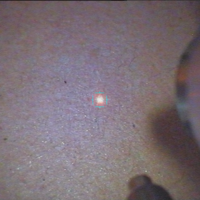
|
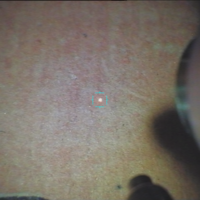
|
| 200px |
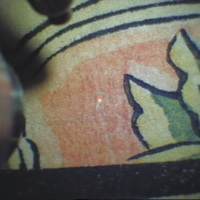
|
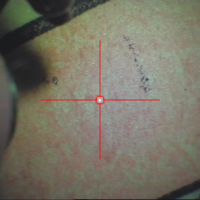
|
| 200px |
Analysis
Excitation Emission Matrix (EEM) spectroscopy can easily identify the organic reds: safflower, madder, and sappanwood. Safflower fluoresces under UVA radiation and produces a unique EEM plot, even when the safflower has visually faded to a dull brownish red. In addition to the fluorescence for the red chromophor, the pattern often contained an additional peak for the yellow chromophore that was supposedly removed in the preparation of the red colorant but often needed several washings for complete elimination.
Other Images of Safflower
List of Prints
Below is a list of prints where safflower was detected.
